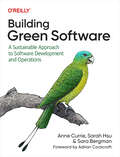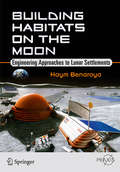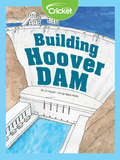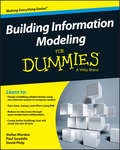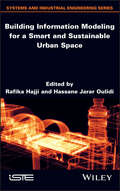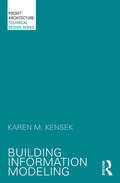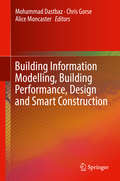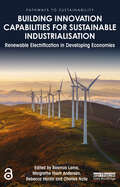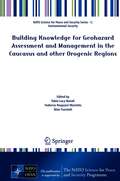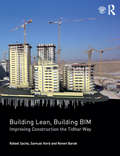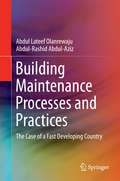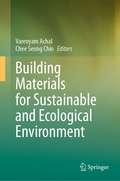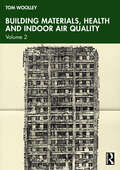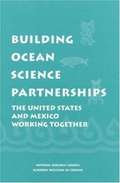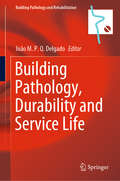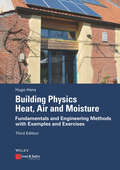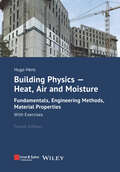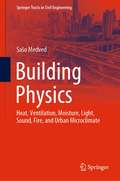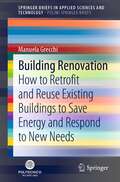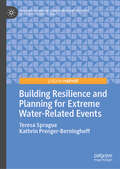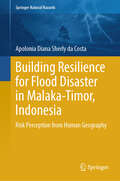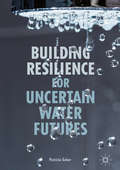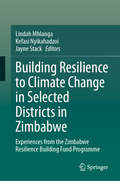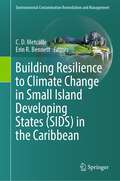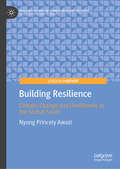- Table View
- List View
Building Green Software: A Sustainable Approach to Software Development and Operations
by Anne Currie Sarah Hsu Sara BergmanHow will software development and operations have to change to meet the sustainability and green needs of the planet? And what does that imply for development organizations? In this eye-opening book, sustainable software advocates Anne Currie, Sarah Hsu, and Sara Bergman provide a unique overview of this topic—discussing everything from the likely evolution of national grids to the effect those changes will have on the day-to-day lives of developers.Ideal for everyone from new developers to CTOs, Building Green Software tackles the challenges involved and shows you how to build, host, and operate code in a way that's not only better for the planet but also cheaper and relatively low-risk for your business. Most hyperscale public cloud providers have already committed to net-zero IT operations by 2030. This book shows you how to get on board.You'll explore:How the energy transition is likely to change hosting on prem and in the cloud—and how your company can prepareThe fundamental architectural principles of sustainable software development and how to apply themHow to determine which parts of your system need to changeThe concept of extending hardware longevity and the part that software plays
Building Habitats on the Moon: Engineering Approaches to Lunar Settlements (Springer Praxis Books)
by Haym BenaroyaDesigning a habitat for the lunar surface? You will need to know more than structural engineering. There are the effects of meteoroids, radiation, and low gravity. Then there are the psychological and psychosocial aspects of living in close quarters, in a dangerous environment, far away from home. All these must be considered when the habitat is sized, materials specified, and structure designed. This book provides an overview of various concepts for lunar habitats and structural designs and characterizes the lunar environment - the technical and the nontechnical. The designs take into consideration psychological comfort, structural strength against seismic and thermal activity, as well as internal pressurization and 1/6 g. Also discussed are micrometeoroid modeling, risk and redundancy as well as probability and reliability, with an introduction to analytical tools that can be useful in modeling uncertainties.
Building Hoover Dam
by Liz HuyckHave you ever wondered how the Hoover Dam was built? Follow along as the Colorado River itself tells you its story! A lot of work went into the construction of this giant dam, but it was worth it—we now have Lake Mead and a way of converting the river’s energy into electricity!
Building Information Modeling For Dummies
by Stefan Mordue Paul Swaddle David PhilpEverything you need to make the most of building information modeling If you're looking to get involved in the world of BIM, but don't quite know where to start, Building Information Modeling For Dummies is your one-stop guide to collaborative building using one coherent system of computer models rather than as separate sets of drawings. Inside, you'll find an easy-to-follow introduction to BIM and hands-on guidance for understanding drivers for change, the benefits of BIM, requirements you need to get started, and where BIM is headed. The future of BIM is bright—it provides the industry with an increased understanding of predictability, improved efficiency, integration and coordination, less waste, and better value and quality. Additionally, the use of BIM goes beyond the planning and design phase of the project, extending throughout the building life cycle and supporting processes, including cost management, construction management, project management, and facility operation. Now heavily adopted in the U.S., Hong Kong, India, Singapore, France, Canada, and countless other countries, BIM is set to become a mandatory practice in building work in the UK, and this friendly guide gives you everything you need to make sense of it—fast. Demonstrates how BIM saves time and waste on site Shows you how the information generated from BIM leads to fewer errors on site Explains how BIM is based on data sets that describe objects virtually, mimicking the way they'll be handled physically in the real world Helps you grasp how the integration of BIM allows every stage of the life cycle to work together without data or process conflict Written by a team of well-known experts, this friendly, hands-on guide gets you up and running with BIM fast.
Building Information Modeling for a Smart and Sustainable Urban Space
by Hassane Jarar Oulidi Rafika HajjiUrban spaces are being called upon to develop a capacity for resilience and sustainability in order to meet the major challenges they face. To achieve such a goal, a practical development framework must be implemented in order to take advantage of the technological innovations that characterize the field of construction and urban engineering. Today, multi-scale BIM is bringing about significant changes that are redefining the paradigms of urban management. It facilitates simulations of the sustainability of urban spaces with respect to several criteria; most notably relating to energy, the economy and the environment.Building Information Modeling for a Smart and Sustainable Urban Space proposes a theoretical and practical framework for implementing BIM models for the creation of sustainable and intelligent urban spaces. It addresses the issues of acquisition, modeling, interoperability, and BIM and GIS integration for the production of BIM models. Case studies are presented, providing a practical dimension that demonstrates the production process of the urban model and its contribution to multiscale simulations, particularly in real estate evaluation and urban renewal.
Building Information Modeling: Bim In Current And Future Practice (PocketArchitecture)
by Karen M. KensekThis is a design guide for architects, engineers, and contractors concerning the principles and specific applications of building information modeling (BIM). BIM has the potential to revolutionize the building industry, and yet not all architects and construction professionals fully understand what the benefits of BIM are or even the fundamental concepts behind it. As part of the PocketArchitecture Series it includes two parts: fundamentals and applications, which provide a comprehensive overview of all the necessary and essential issues. It also includes case studies from a range of project sizes that illustrate the key concepts clearly and use a wide range of visual aids. Building Information Modeling addresses the key role that BIM is playing in shaping the software tools and office processes in the architecture, engineering, and construction professions. Primarily aimed at professionals, it is also useful for faculty who wish to incorporate this information into their courses on digital design, BIM, and professional practice. As a compact summary of key ideas it is ideal for anyone implementing BIM.
Building Information Modelling, Building Performance, Design and Smart Construction
by Mohammad Dastbaz Chris Gorse Alice MoncasterThis book charts the path toward high performance sustainable buildings and the smart dwellings of the future. The volume clearly explains the principles and practices of high performance design, the uses of building information modelling (BIM), and the materials and methods of smart construction. Power Systems, Architecture, Material Science, Civil Engineering and Information Systems are all given consideration, as interdisciplinary endeavours are at the heart of this green building revolution.
Building Innovation Capabilities for Sustainable Industrialisation: Renewable Electrification in Developing Economies (Pathways to Sustainability)
by Rasmus Lema, Margrethe Holm Andersen, Rebecca Hanlin and Charles NzilaThis book argues that renewable electrification in developing countries provides important opportunities for local economic development, but new pathways are required for turning these opportunities into successful reality. Building Innovation Capabilities for Sustainable Industrialisation offers a novel input into the debate on development of capabilities for sustainable industrialisation and delivers key insights for both researchers and policy makers when it comes to the question of how to increase the economic co-benefits of renewables expansion. The chapters in the book use a tailored analytical framework in their studies of renewable electrification efforts in Kenya and other countries in sub-Saharan Africa. They draw on a mix of project, sector and country level case studies to address questions such as: What capabilities are developed through on-going renewable electrification projects in developing economies? How can the expansion of renewable electrification be supported in a way that also encourages sustainable economic development? What role do international linkages (South-South and North-South) play and what role should they play in the greening of energy systems in developing economies? The authors provide a new understanding of how green transformation and sustainable industrialisation can be combined, highlighting the opportunities and constraints for local capability building and the scope for local policy action. This book will be of great interest to students and scholars of development studies, energy studies, sustainability and sustainable development, as well as practitioners and policy makers working in development organisations and national governments.
Building Knowledge for Geohazard Assessment and Management in the Caucasus and other Orogenic Regions (NATO Science for Peace and Security Series C: Environmental Security)
by Fabio Luca Bonali Federico Pasquaré Mariotto Nino TsereteliThis volume is aimed at providing a comprehensive overview of the state of art of research related to geo-related hazards in the Caucasus and other orogenic regions; it is also devoted to shedding light on a broad array of geological phenomena as well as discussing innovative tools and strategies for geohazard assessment. Additional emphasis is placed on preventive and mitigation measures, which might be helpful in tackling seismic, volcanic and landslide risks affecting major lifelines and infrastructures. The innovative, multidisciplinary methodologies illustrated in this volume may be successfully applied to other orogenic regions across the globe. The book features major scientific contributions from experts working on different Earth Science topics, such as seismology, structural geology, applied geology and volcanology. Its chapters describe a wide gamut of cutting-edge research methodologies and are thus intended to be read and shared by the worldwide Earth Science community. In particular, the readers will have a chance to gain a thorough knowledge of a number of key geological features that can be observed across both the Greater and Lesser Caucasus. Moreover, the volume provides a thorough description of the techniques employed to assess seismic hazard in major cities - such as microzonation - and an overview of the efforts taken to monitor and prevent seismic and landslide hazard posed to vital energy infrastructures in the Caucasus region.
Building Lean, Building BIM: Improving Construction the Tidhar Way
by Rafael Sacks Samuel Korb Ronen BarakBuilding Lean, Building BIM is the essential guide for any construction company that wants to implement Lean Construction and Building Information Modelling (BIM) to gain a strategic edge over their competition. The first of its kind, the book outlines the principles of Lean, the functionality of BIM, and the interactions between the two, illustrating them through the story of how Tidhar Construction has implemented Lean Construction and BIM in a concerted effort over four years. Tidhar is a small-to-medium-sized construction company that pioneered a way of working that gave it a profit margin unheard of in its market. The company's story serves as a case study for explanation of the various facets of Lean Construction and BIM. Each chapter defines a principle of Lean and/or BIM, describes the achievements and failures in Tidhar's implementation based on the experiences of the key people involved, and reviews the relevant background and theory. The implementation at Tidhar has not been a pure success, but by examining their motives alongside their achievements and failures, readers will learn about what pitfalls and pinnacles to expect. A number of chapters also compare the experience of Tidhar with those of other companies who are leaders in their fields, such as Skanska and DPR. This book is highly relevant and useful to a wide range of readers from the construction industry, especially those who are frustrated with the inefficiencies in their companies and construction projects. It is also essential reading for Lean and BIM enthusiasts, researchers and students from a variety of industries and backgrounds.
Building Maintenance Processes and Practices: The Case of a Fast Developing Country
by Abdul Lateef Olanrewaju Abdul-Rashid Abdul-AzizThis book is designed to be an inclusive for the best practice approach to building maintenance management, where the processes, procedures and operational systems meet a high standard of professional and academic competence. It offers a different perspective on building maintenance management by presenting the schematic building maintenance value chain model and it's implementation in Malaysian university buildings. The findings show an improvement to building performance, lower maintenance cost, building sustainability and increased maintenance service user satisfaction. The learning outcomes and summaries provided for each chapter and the extensive use of tables and figures add to the readability of the text. Though the book is based on data from Malaysia, it is useful for a much wider audience, and the informal writing style makes it an interesting reference source. This book is valuable for readers who are practitioners, professionals and for academic institutions that offer courses in the building field, including architecture, quantity surveying, civil engineering, building and facility management, property management, real estate. It will also be of interest to governments and others involved in the construction industry.
Building Materials for Sustainable and Ecological Environment
by Varenyam Achal Chee Seong ChinThis book uses theories, hypotheses, policies, practical insights and case studies to introduce and elucidate green building materials for sustainable construction. Cement is the most widely used building material in construction; however, it is not sustainable, being responsible for 7% of global carbon dioxide emissions and consuming huge quantities of energy. In order to limit the ecological damage, sustainable building materials are needed. Ecosystems are a source of important lessons and models for transitioning the built environment onto a sustainable path that opens options for sustainable building material in construction. The book provides a guide for readers seeking knowledge on sustainable building materials with the potential to lower environmental impact by reducing CO2 emission throughout the building’s lifecycle. The book is motivated by recent rapid advances in sustainable building materials production, including green building materials made of industrial by-products and recycled wastes, earth materials, plant-based materials, microbial-based materials or supplementary cementitious materials, to reduce the environmental impacts of traditional building materials. Discussing the development and applications of various sustainable building materials, including related case studies, and addressing the environmental issue with a holistic and systematic approach that creates an ecology of construction for sustainability in infrastructures, it offers promising solutions to achieve renewable and sustainable building materials for the future.
Building Materials, Health and Indoor Air Quality: Volume 2
by Tom WoolleyIn Building Materials, Health and Indoor Air Quality: Volume 2 Tom Woolley uses new research to continue to advocate for limiting the use of hazardous materials in construction and raise awareness of the links between pollutants found in building materials, poor indoor air quality and health problems. Chapters in this volume reinforce previous arguments and present new ones covering: Further evidence of the health impacts of hazardous emissions from materials Hazardous materials to be avoided and why Fire and smoke toxicity – the Lakanal House and Grenfell Tower legacy Sub-standard retrofits leading to damp and mould in previously sound houses A critical review of recent reports from UK Government and others on air quality and health problems including policy changes on flame retardants Growing evidence of cancer risks and the failure of cancer research organisations to address these issues A critical review of recent climate change and zero carbon policies and a discussion on whether extreme energy efficiency is a good thing This book asks some important and, for some, uncomfortable questions, but in doing so it brings to light important areas for research and provides much needed guidance for architects, engineers, construction professionals, students and researchers on hazardous materials and how to reduce their use and design and build healthier buildings for all occupants.
Building Ocean Science Partnerships: The United States and Mexico Working Together
by AMC-NRC Joint Working Group on Ocean SciencesBuilding Ocean Science Partnerships describes a set of potential ocean science projects for cooperative research between scientists from the United States and Mexico, particularly focused on the Pacific Coast of California and Baja California, the Gulf of California, and the Gulf of Mexico. Barriers to cooperation between scientists of the two nations are identified, and methods to overcome such barriers are recommended.The book describes how interactions can be promoted by enhancing opportunities for education and training, building and sharing scientific infrastructure, participating together in large-scale marine research programs and regional ocean observing systems, planning joint science events and publications, and developing sources of binational funding. Building Ocean Science Partnerships will be published in English and Spanish to make its contents widely accessible in the United States and Mexico.
Building Pathology, Durability and Service Life (Building Pathology and Rehabilitation #12)
by J. M. P. Q. DelgadoThis book provides a collection of recent research works, helping contribute to the systematization and dissemination of the latest findings on building pathologies (structural and hygrothermal), salt attack and corrosion, durability and service-life prediction. It reflects a number of recent advances concerning the above-mentioned topics, particularly in concrete structures. Intended as an overview of the current state of knowledge, the book will benefit scientists, students, practitioners, lecturers and other interested parties. At the same time, the topics covered are relevant to a variety of scientific and engineering disciplines, including civil, materials and mechanical engineering.
Building Physics - Heat, Air and Moisture: Fundamentals and Engineering Methods with Examples and Exercises
by Hugo S. HensBad experiences with construction quality, the energy crises of 1973 and 1979, complaints about "sick buildings", thermal, acoustical, visual and olfactory discomfort, the need for good air quality, the move towards more sustainability - all these have accelerated the development of a field that, for a long time, was hardly more than an academic exercise: building physics (in English speaking countries sometimes referred to as building science). The discipline embraces domains such as heat and mass transfer, building acoustics, lighting, indoor environmental quality and energy efficiency. In some countries, fire safety is also included. Through the application of physical knowledge and its combination with information coming from other disciplines, the field helps to understand the physical phenomena governing building parts, building envelope, whole buildings and built environment performance, although for the last the wording "urban physics" is used. Today, building physics has become a key player on the road to a performance based building design. The book deals with the description, analysis and modeling of heat, air and moisture transport in building assemblies and whole buildings with main emphasis on the building engineering applications, including examples. The physical transport processes determine the performance of the building envelope and may influence the serviceability of the structure and the whole building. Compared to the second edition, in this third edition the text has partially been revised and extended.
Building Physics - Heat, Air and Moisture: Fundamentals, Engineering Methods, Material Properties and Exercises
by Hugo S. HensBad experiences with construction quality, the energy crises of 1973 and 1979, complaints about "sick buildings", thermal, acoustical, visual and olfactory discomfort, the need for good air quality, the move towards energy efficiency, decarbonization and sustainability ? all these have accelerated the development of a discipline that, for a long time, was hardly more than an academic exercise: building physics. The discipline embraces domains such as heat and mass transfer, building acoustics, lighting, indoor environmental quality, energy efficiency, and, in some countries, fire safety. Through the application of physical knowledge and its combination with information coming from other disciplines, building physics helps to under-stand the physical phenomena governing building parts, building envelope, whole building and built environment performance ? called urban physics. Today, building physics has be-come a key player on the road to highly performing new buildings and renovations. This book deals with heat, air and moisture transport in building parts or assemblies and whole buildings with emphasis on the building engineering applications. Compared to the third edition, this fourth edition has been expanded in chapter 1 to include the physical determination of the thermal conductivity of materials, together with an in-depth discussion of all the effects of thicker insulation layers. In chapter 2, additional information has been added on wind pressure and the evaluation of condensation inside the building com-ponents, while a new chapter 4 on material properties has been included. The whole book, including the figures, has been revised and restructured where necessary.
Building Physics: Heat, Ventilation, Moisture, Light, Sound, Fire, and Urban Microclimate (Springer Tracts in Civil Engineering)
by Sašo MedvedThe book presents the theoretical background of building physics, dealing with the evaluation of physical phenomena related to heat transfer and energy use in buildings, water and water vapour transfer in building structures, daylighting and electric lighting of buildings, sound transmission in building structures and protection against noise, the occurrence and spread of fires in buildings and the thermal response of cities. It contains numerical and computational evaluation methods, numerous computational case studies and examples of experimental analyses. The book demonstrates that the considered physical processes affect the quality of living and working comfort in indoor and outdoor environment.
Building Renovation: How to Retrofit and Reuse Existing Buildings to Save Energy and Respond to New Needs (SpringerBriefs in Applied Sciences and Technology)
by Manuela GrecchiThis book reviews the building renovation process by systematizing the phases of analysis and prior knowledge through a project that not only considers energy savings but also thoroughly examines complex issues, such as defining the correct new functions and answers to new needs. The urgency of climate change and the many problems associated with the excessive use of energy are forcing a reorganization of the renovation process with an interest in reusing existing buildings with a more sustainable approach. The adaptive transformation of old buildings has become a dominant theme in many urban renewal projects. It must necessarily include strategies for energy efficiency, reduced pollutant emissions, improved environmental performance, economic sustainability and cultural identity. The examples selected are intended to provide evidence of good practices in the review and transformation of old buildings.
Building Resilience and Planning for Extreme Water-Related Events (Palgrave Studies in Climate Resilient Societies)
by Teresa Sprague Kathrin Prenger-BerninghoffThis book discusses what it means for cities to work toward and achieve resilience in the face of climate change. The content takes an urban planning perspective with a water-related focus, exploring the continued global and local efforts in improving disaster risk management within the water sphere. Chapters examine four cities in the US and Germany - San Francisco, San Diego, Solingen and Wuppertal - as the core case studies of the discussion. The chapters for each case delve into the current status of the cities and issues resilience must overcome, and then explore solutions and key takeaways learned from the implementation of various resilience approaches. The book concludes with a summary of cross-cutting themes, best-practice examples and a reflection on the relevance of the approaches to cases in the wider developing world. This book engages both practitioners and scientific audiences alike, particularly those interested in issues addressed by the Sendai Framework for Disaster Risk Reduction 2015-2030, the 2030 Agenda for Sustainable Development, the recent Water Action Decade 2018-2028 and the Rockefeller Foundation’s 100 Resilient Cities.
Building Resilience for Flood Disaster in Malaka-Timor, Indonesia: Risk Perception from Human Geography (Springer Natural Hazards)
by Apolonia Diana da CostaThis book provides a new and different perspective on human geography as an umbrella understanding of the social science of disaster management, but it is simple to understand, where disaster-affected communities anywhere, for example in this study in disaster communities in Malacca-Timor, eastern Indonesia (female/customary land) can respond to flood disasters with the resilience capacity they have day after day. What is presented in this book is very relevant and indicates the concept of resilience to flood disasters from the perspective of the community (human geography) through the use of applied science along with practical social methods or approaches combined with applied GIS data in the form of nine spatial distribution maps of each resilience capacity/asset that flood-affected communities have in coping with disaster impacts or risks. In the relevance of human geography, natural disasters, and spatial studies, we as readers jointly find a bright spot in this book, that natural vulnerability has an impact on physical, social, cultural, economic, religious, legal, and political vulnerabilities, where communities experiencing flood hazards need to learn to deal with and/or practice the resources they have. The resources they have in the scientific trajectory of human geography, disaster management, and spatial studies are specialized in understanding how effective, efficient, and adequate the resilience they have in the study of sustainable livelihood development, is based on the lens of social-ecological integrity. This book provides a clear and digestible understanding for all readers from interdisciplinary scientific backgrounds.
Building Resilience for Uncertain Water Futures
by Patricia GoberThis book describes the existential threats facing the global water systems from population growth and economic development, unsustainable use, environmental change, and weak and fragmented governance. It argues that ‘business-as-usual’ water science and management cannot solve global water problems because today’s water systems are increasingly complex and face uncertain future conditions. Instead, a more holistic, strategic, agile and publically engaged process of water decision making is needed.Building Resilience for Uncertain Water Futures emphasises the importance of adaptation through a series of case studies of cities, regions, and communities that have experimented with anticipatory policy-making, scenario development, and public engagement. By shifting perspective from an emphasis on management to one of adaptation, the book emphasizes the capacity to manage uncertainties, the need for cross-sector coordination, and mechanisms for engaging stakeholder with differing goals and conflict resolution. This book will be a useful resource for students and academics seeking a better understanding of sustainable water use, water policy and water resources management.
Building Resilience to Climate Change in Selected Districts in Zimbabwe: Experiences from the Zimbabwe Resilience Building Fund Programme
by Lindah Mhlanga Kefasi Nyikahadzoi Jayne StackThe book is based on Zimbabwe Resilience Building Fund data from the Outcome Monitoring Surveys 1,2,3 (OMS123) which comprised of three rounds of panel data set with the same households being interviewed three consecutive times in 18 districts. The OMS1, OMS2 and OMS3 were undertaken in 2019, 2020 and 2021, respectively. The findings in this book demonstrate and provide a better understanding of what works and what does not work to strengthen communities’ resilience in Zimbabwe. The information contributed in each chapter will be useful to inform adaptive programming and design of future resilience interventions and policy, with a focus on Climate Resilient Development (CRD). The chapters also address the challenge of formulating concrete policy in an environment with severe data constraints.
Building Resilience to Climate Change in Small Island Developing States (Environmental Contamination Remediation and Management)
by C. D. Metcalfe Erin R. BennettThis book summarizes approaches that integrate the environmental, economic, and physical domains with the values, and needs of the population are necessary to develop sustainable strategies that will enhance the resilience of small islands, within the context of inter-island differences in geology, ecology, societal attitudes, governance, and human and economic resources. The impacts of coastal damage and flooding are predicted to worsen during this century due to rising sea levels and increases in the frequency and intensity of storms. The usual approach to coastal protection in Small Island Developing States (SIDS) in the Caribbean is to view both the hazards and the solutions from the “Ocean Side” perspective and to react with “hard” engineering solutions. These structural engineering approaches prevent damage and disruptions to services associated with predictable events but leave communities vulnerable to future events that do not follow historical trends. Furthermore, engineered structures do not adequately address the systemic nature of climate change nor account for compounding threats (e.g., coincidence of hurricane season and global pandemics). To move from this traditional strategy for managing risks from coastal hazards, we need to consider a portfolio of solutions that enhance island protection and community resilience. Nature-Based Solutions (NBS) are gaining attention as practical and cost-effective approaches for mitigating climate-based stressors. However, deployment of NBS strategies requires spatial coordination within the context of “ridge to reef” or integrated water resource management (IWRM) approaches that include the creation of conditions for social acceptance, equity, effective governance, and financial incentives.
Building Resilience: Climate Change and Livelihoods in the Global South (Palgrave Studies in Climate Resilient Societies)
by Nyong Princely AwaziThis book explores the intersection of climate resilience, livelihoods, and sustainability in various sectors – from forestry to fisheries and agriculture – within the global South. The author provides a comprehensive examination of how climate change impacts these communities, the adaptive strategies they employ, and the policy frameworks necessary for promoting resilience. Through a multidisciplinary approach that integrates ecological, economic, and social dimensions, this book is an essential resource for policymakers, researchers, and practitioners in fields relating to fishery, forestry and agriculture in the global South.
